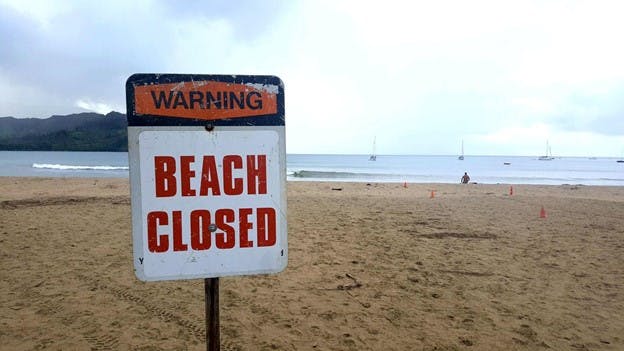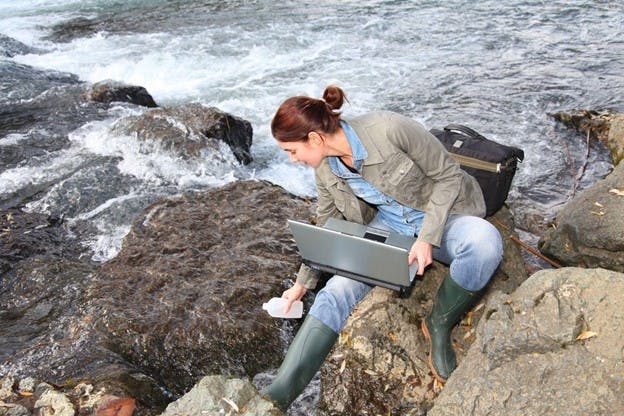April 2023
From Droughts to Water Quality, Los Angeles Water Faces Some Challenges
The City of Angels is one of the most iconic cities in the world. Built on a sprawling desert basin and surrounded by mountains and beaches, LA has attracted starry-eyed dreamers from over 140 countries. Los Angeles is the place to go for great shopping, amazing restaurants, unique experiences, and of course, it’s the home of Hollywood.
As residents know all too well, the city is so much more than a landing spot for would-be actors. With a population of 10 million people, Los Angeles County is the most populated county in the United States. If LA County were its own state, it would be the seventh largest in the country by population. That’s a lot of people and businesses both relying on, and putting strain on, city and county services like water and sewage.
If we take a look at tap water quality, Los Angeles is a bit of a mixed bag. Let’s examine the Los Angeles Water Quality Report to better understand what they are doing well and what could use some work.
Where Does the Los Angeles Water Supply Come From?
One of the biggest draws to Southern California has always been its beautiful weather, and Los Angeles is no exception. The mild-to-hot year-round temperatures, low humidity, and absence of many rainy days makes every day one to enjoy being outside. But when you have 10 million people in need of water, having very little rain can quickly become a curse.
The water-sourcing problems facing Southern California are not about to get any easier. The last 22 years in the western United States have been the driest in over 1,200 years. This makes sourcing a steady supply of clean water an increasingly difficult challenge.
The Los Angeles County Waterworks Districts — which is responsible for supplying Angelenos with drinking water — is constantly working with residents and state regulators to make this scarce resource stretch just a little further. It’s important that they continue to develop and protect local fresh water sources since there’s already not enough water to go around. Most of the water that comes out of your faucet is imported.
Currently, LA gets its water supplies from four main sources:
- Imports: Almost 75% of Los Angeles’ needs are met with water imported from Northern California through the State Water Project. This water originates in the Sierra Nevada and goes through hundreds of miles of pipes to get to LA County.
- Groundwater and rivers: Roughly 25% of drinkable water comes from local, sustainable groundwater aquifers and the Colorado River Aqueduct.
- Recycled water: Less than 1% of LA water supplies come from recycled water but there are plans to grow this. Recycled water is valuable for outdoor irrigation of public spaces.
- Banked water: In case of emergencies or severe droughts that may disrupt access to water or damage local water quality, Los Angeles keeps 140,000 acre-feet of water banked in nearby Kern County.
Importing 75% of the water supply for 10 million people is not easy. The State Water Project consists of 660 miles of pipes and canals, dedicated power plants, water pumping stations, reservoirs, and holding tanks. The project spans two-thirds the length of the state.
How Is Los Angeles Water Quality?
All natural water sources have their own unique characteristics. Natural minerals in the earth as well as human and animal activity can alter water quality. Los Angeles gets its water from multiple sources that are hundreds of miles apart. This can make for an interesting mix of contaminants we’ll detail below.
One of the biggest threats to water quality locally is manmade pollution. More and more the Department of Public Health is issuing warnings and even closing state beaches due to high bacteria levels in the ocean water. The current contaminant levels make swimming in popular beaches like Mother’s Beach, Marina Del Rey, Malibu, Redondo, and the Santa Monica Pier a public health risk.
While LA doesn’t get its drinking water from the ocean, the low beach water quality Los Angeles residents are forced to endure is a symptom of a bigger problem — millions of people means lots of pollution.
The high concentrations of bacteria in ocean water come from runoff into storm drains and untreated sewage that gets emptied into the ocean when the treatment plants are unable to keep up.
In the last few years, there have been many stories of raw sewage spills into waterways. In the summer of 2021, 17 million gallons of sewage were released into the Santa Monica Bay, and five months later 8.5 million gallons spilled into the flood control waterway.
Pollution doesn’t just end up in the ocean — it also ends up in the groundwater where drinking water comes from. In fact, 40% of the groundwater wells Los Angeles gets its water from were found to have worrying levels of contaminants.
Is Los Angeles Tap Water Safe to Drink?
The U.S Environmental Protection Agency (EPA) and the State Water Resources Control Board require the cities in Los Angeles County to put out a Water Quality Report each year. This report compares LA water to the current safe drinking water standards established by these two organizations.
The most recent reports looking at data from 2021 indicate that LA water is safe to drink.
However, this is not the whole story. There are thousands of chemical contaminants out there that just aren’t tested for. While California is leading the charge on testing for many contaminants and has some of the most strict water standards in the country, many contaminants — like microplastics — are almost impossible to test for with current technology. Many other chemicals we don’t know much about yet, and still many others have become a concern to scientists but regulation on them hasn’t yet caught up.
The Environmental Working Group (EWG) — the D.C.-based water watchdog group — points out that the EPA hasn’t updated its contaminant list in almost 20 years. For context, the EPA sets the standards for public drinking supplies across the U.S.
Even in many of the contaminants that are tested for, there is a wide divide in what is legally acceptable and what the EWG says is safe based on the most recent research.
EWG Water Quality in Los Angeles Reports
California has some of the most strict standards in the country for their drinking water. Many of EWG’s standards actually come from the health goals of California health agencies. EWG’s uranium recommendations, for example, come from the public health goals set by California. As you’ll see though, just because they set a goal doesn’t mean cities in California come close to meeting it.
Here are some of the contaminants in LA water that exceeded the limits set by EWG for good health.
Haloacetic Acids (HAA5)
There are five haloacetic acids that make up HAA5: monochloroacetic acid, dichloroacetic acid, trichloroacetic acid, monobromoacetic acid, and dibromoacetic acid. These chemicals are known as disinfectant byproducts as they result from disinfectants like chlorine interacting with organic matter in water. Long-term exposure to HAA5 can lead to cancer.
Levels of HAA5 in Los Angeles water are a whopping 103x what the EWG recommends for safety:
- EPA maximum allowance: 60 parts per billion (ppb)
- EWG recommended maximum: 0.1 ppb
- Los Angeles maximum contaminant level: 10.3 ppb
Haloacetic Acids (HAA9)
HAA9 includes all of the contaminants from HAA5 but adds bromochloroacetic acid, bromodichloroacetic acid, chlorodibromoacetic acid, and tribromoacetic acid. These are also disinfectant byproducts and are also cancer-causing.
Levels of HAA9 in Los Angeles water have exceeded what the EWG recommends for safety by 184x:
- EPA maximum allowance: No legal limit
- EWG recommended maximum: 0.06 ppb
- Los Angeles maximum contaminant level: 11 ppb
Total Trihalomethanes (TTHMs)
TTHMs — like the haloacetic acids above — are formed when chlorine interacts with organic compounds in drinking water. They’re also known to be carcinogenic. This category is made up of four chemicals: chloroform, bromodichloromethane, dibromochloromethane, and bromoform.
Levels of TTHMs in Los Angeles water have exceeded what the EWG recommends for safety by 177x:
- EPA maximum allowance: 80 ppb
- EWG recommended maximum: 0.15 ppb
- Los Angeles maximum contaminant level: 26.6 ppb
Chromium (Hexavalent)
Chromium is a common heavy metal contaminant often found in U.S. water supplies. It’s both naturally occurring and an industrial byproduct. Although it’s a known carcinogen, the EPA still doesn’t regulate it.
Chromium levels in Los Angeles water have exceeded what the EWG recommends for safety by 29x:
- EPA maximum allowance: No legal limit
- EWG recommended maximum: 0.02 ppb
- Los Angeles maximum detected level: 0.586 ppb
Arsenic
Arsenic is carcinogenic and is known to cause damage to the brain, central nervous system, skin, and blood vessels. Arsenic is a common contaminant in U.S. public drinking water because it can occur naturally in groundwater.
Arsenic levels in Los Angeles water have exceeded what the EWG recommends for safety by 430x:
- EPA maximum allowance: 10 ppb
- EWG recommended maximum: 0.004 ppb
- Los Angeles maximum detected level: 1.72 ppb
Nitrates
Nitrates are a fertilizer byproduct that usually get introduced into drinking water systems through storm water runoff and discharges from septic tanks/water treatment plants. Nitrates can inhibit oxygen intake by your blood cells and are especially dangerous to infants. Nitrates can also cause cancer.
Nitrate levels in Los Angeles water have exceeded what the EWG recommends for safety by 12x:
- EPA maximum allowance: 10 parts per million (ppm)
- EWG recommended maximum: 0.14 ppm
- Los Angeles maximum detected level: 1.69 ppm
Uranium
Uranium is a radioactive heavy metal found both in nature and as a byproduct of oil and gas production. Uranium is a known carcinogen. Legal limits for uranium are measured in picocuries per liter (pCi/L), which is a measure of radioactivity.
Uranium levels in Los Angeles water have exceeded what the EWG recommends for safety by 7x:
- EPA maximum allowance: 20 pCi/L
- EWG recommended maximum: 0.43 pCi/L
- Los Angeles maximum detected level: 3.0 pCi/L
Does Los Angeles Have Hard Water?
The groundwater in and around Los Angeles is some of the hardest in the country. However, because much of the tap water in LA is imported from different places, you may have harder or softer water than the people in the next town over.
Hard water occurs when groundwater passes over mineral dense rocks and soil. Because water is corrosive, it can wear down the mineral deposits and carry them along for the ride. The hardness of water measures the amount of mineral solids like calcium and magnesium that water contains. These small bits of minerals are like tiny rocks that adhere themselves to the inside of your pipes, your water-using appliances, and your home surfaces. They can wear out fabrics, make soap less effective, and give bacteria a place to grow.
HomeWater’s Salt-Free Water Softener and Conditioner gets rid of these hard water minerals without the hassle and maintenance of traditional water softeners.
How to Know You’re Getting the Best Home Water Quality in Los Angeles
When it comes to finding enough supply and maintaining high water quality, Los Angeles has some unique circumstances. If you have concerns about the water coming into your home or you just want to know you’re getting the best-tasting water possible, water filtration could be the answer for you.
HomeWater’s 4-Stage Whole Home Water Filters are designed to improve your water quality by removing harmful and bad-tasting impurities like chlorine, heavy metals, microorganisms, and more. Plus you can attach our Salt-Free Water Softener for a complete home solution for all your water concerns.
If you’re looking for something to give you great protection that’s easier to install, our 4-Stage Under Counter Water Filter with Reverse Osmosis will remove chlorine, lead, copper, disinfectant byproducts, radium, chromium, nitrates, and so much more.
With HomeWater’s American-made water filters, you always know you’re getting the best-tasting, cleanest water with every sip.
Related Articles
February 2023
The Important Facts About Chicago Water Quality
January 2023



